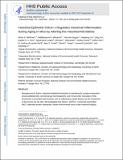| dc.contributor.author | Wellman, Alicia S. | |
| dc.contributor.author | Metukuri, Mallikarjuna R. | |
| dc.contributor.author | Kazgan, Nevzat | |
| dc.contributor.author | Xu, Xiaojiang | |
| dc.contributor.author | Xu, Qing | |
| dc.contributor.author | Ren, Natalie S.X. | |
| dc.contributor.author | Shanahan, Michael T. | |
| dc.contributor.author | Kang, Ashley | |
| dc.contributor.author | Chen, Willa | |
| dc.contributor.author | Azcarate-Peril, M. Andrea | |
| dc.contributor.author | Gulati, Ajay S. | |
| dc.contributor.author | Fargo, David C. | |
| dc.contributor.author | Li, Xiaoling | |
| dc.contributor.author | Guarente, Leonard Pershing | |
| dc.contributor.author | Czopik, Agnieszka | |
| dc.date.accessioned | 2018-11-08T15:44:27Z | |
| dc.date.available | 2018-11-08T15:44:27Z | |
| dc.date.issued | 2017-09 | |
| dc.identifier.issn | 0016-5085 | |
| dc.identifier.issn | 1528-0012 | |
| dc.identifier.uri | http://hdl.handle.net/1721.1/118956 | |
| dc.description.abstract | Intestinal epithelial homeostasis is maintained by complex interactions among epithelial cells, commensal gut microorganisms, and immune cells. Disruption of this homeostasis is associated with disorders such as inflammatory bowel disease (IBD), but the mechanisms of this process are not clear. We investigated how Sirtuin 1 (SIRT1), a conserved mammalian NAD+-dependent protein deacetylase, senses environmental stress to alter intestinal integrity. Methods We performed studies of mice with disruption of Sirt1 specifically in the intestinal epithelium (SIRT1 iKO, villin-Cre+, Sirt1flox/floxmice) and control mice (villin-Cre-, Sirt1[superscript flox/flox]) on a C57BL/6 background. Acute colitis was induced in some mice by addition of 2.5% dextran sodium sulfate to drinking water for 5–9 consecutive days. Some mice were given antibiotics via their drinking water for 4 weeks to deplete their microbiota. Some mice were fed with a cholestyramine-containing diet for 7 days to sequester their bile acids. Feces were collected and proportions of microbiota were analyzed by 16S rRNA amplicon sequencing and quantitative PCR. Intestines were collected from mice and gene expression profiles were compared by microarray and quantitative PCR analyses. We compared levels of specific mRNAs between colon tissues from age-matched patients with ulcerative colitis (n=10) vs without IBD (n=8, controls). Results Mice with intestinal deletion of SIRT1 (SIRT1 iKO) had abnormal activation of Paneth cells starting at the age of 5–8 months, with increased activation of NF-κB, stress pathways, and spontaneous inflammation at 22–24 months of age, compared with control mice. SIRT1 iKO mice also had altered fecal microbiota starting at 4–6 months of age compared with control mice, in part because of altered bile acid metabolism. Moreover, SIRT1 iKO mice with defective gut microbiota developed more severe colitis than control mice. Intestinal tissues from patients with ulcerative colitis expressed significantly lower levels of SIRT1 mRNA than controls. Intestinal tissues from SIRT1 iKO mice given antibiotics, however, did not have signs of inflammation at 22–24 months of age, and did not develop more severe colitis than control mice at 4–6 months. Conclusions In analyses of intestinal tissues, colitis induction, and gut microbiota in mice with intestinal epithelial disruption of SIRT1, we found this protein to prevent intestinal inflammation by regulating the gut microbiota. SIRT1 might therefore be an important mediator of host–microbiome interactions. Agents designed to activate SIRT1 might be developed as treatments for IBDs. Keywords: IBD; mouse model; microbiome; bacteria | en_US |
| dc.publisher | Elsevier BV | en_US |
| dc.relation.isversionof | http://dx.doi.org/10.1053/J.GASTRO.2017.05.022 | en_US |
| dc.rights | Creative Commons Attribution-Noncommercial-Share Alike | en_US |
| dc.rights.uri | http://creativecommons.org/licenses/by-nc-sa/4.0/ | en_US |
| dc.source | PMC | en_US |
| dc.title | Intestinal Epithelial Sirtuin 1 Regulates Intestinal Inflammation During Aging in Mice by Altering the Intestinal Microbiota | en_US |
| dc.type | Article | en_US |
| dc.identifier.citation | Wellman, Alicia S., et al. “Intestinal Epithelial Sirtuin 1 Regulates Intestinal Inflammation During Aging in Mice by Altering the Intestinal Microbiota.” Gastroenterology, vol. 153, no. 3, Sept. 2017, pp. 772–86. | en_US |
| dc.contributor.department | Massachusetts Institute of Technology. Department of Biology | en_US |
| dc.contributor.mitauthor | Czopik, Agnieszka K | |
| dc.contributor.mitauthor | Guarente, Leonard Pershing | |
| dc.relation.journal | Gastroenterology | en_US |
| dc.eprint.version | Author's final manuscript | en_US |
| dc.type.uri | http://purl.org/eprint/type/JournalArticle | en_US |
| eprint.status | http://purl.org/eprint/status/PeerReviewed | en_US |
| dc.date.updated | 2018-10-16T12:47:27Z | |
| dspace.orderedauthors | Wellman, Alicia S.; Metukuri, Mallikarjuna R.; Kazgan, Nevzat; Xu, Xiaojiang; Xu, Qing; Ren, Natalie S.X.; Czopik, Agnieszka; Shanahan, Michael T.; Kang, Ashley; Chen, Willa; Azcarate-Peril, M. Andrea; Gulati, Ajay S.; Fargo, David C.; Guarente, Leonard; Li, Xiaoling | en_US |
| dspace.embargo.terms | N | en_US |
| dc.identifier.orcid | https://orcid.org/0000-0003-4064-2510 | |
| mit.license | OPEN_ACCESS_POLICY | en_US |
